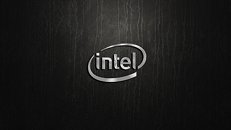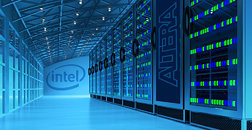Friday, January 27th 2017

Intel Announces Q4 2016 and Full-Year Revenues - Record Q4, YOY
Intel today announced their quarterly earnings for Q4 of the 2016 fiscal year. The company set a new record for revenue for this quarter, coming in at $16.4 billion (up 10% from a year ago, which stood at $14.9B). For the year, Intel brought in $59.4 billion, up 7% from their 2015 results. Intel's gross margin fell, though, by 1.7 points down to a still hugely respectable 60.9%, with operating income of $12.9 billion, down 8% from a year ago. Net income was down 10% to $10.3 billion, and earnings per share fell 9% to $2.12. Intel announced a record annual cash flow from operations of $21.8 billion, with solid earnings with GAAP net income of $10.3 billion, and non-GAAP net income of $13.2 billion.
Leaving the corporate numbers talk behind us for a moment, this means that Intel managed to have another astounding year, with solid execution and even more solid margins and revenues. However, take a peek under the hood, and Intel's wins are based on consumer losses: lower volumes in almost all channels were offset by higher average selling prices (ASP), meaning that Intel is (like any company on the top would) keeping its revenue streams up by charging more for its products.Intel's Client Computing Group, which provides CPUs, SoCs, and wireless and wired connectivity products destined for PCs, had revenue for the year of $32.9 billion, up 2%, but with platform volume being down 10%. The fact that Intel managed to increase revenue with lower volume of shipments is directly charged to the consumer, with an 11% increase in platform selling prices. For the last quarter, the Client Computing Group had revenues of $9.1 billion, up 4% from a year ago, with platform volumes being down 7%, and again, this difference being offset by selling prices up 7%. Desktop platform volume was down 9%, with a lower increase in the ASP at just 2%, while notebook volumes remained flat but with a platform average selling price being up by 3%. What we see here is Intel basically making up the loss in revenue that would be expected with lower channel volume by increasing the ASPs of its platforms - this means the company can try and remain its revenues at the same level, even with lower volume of sales, though this burden then passes towards the consumer, who has to pay more for the same average product. Here's hoping increased competitiveness in the Client and Computing segment will bring more options to consumers, and thus a need for Intel to rethink its revenue targets at the expense of customers.The Data Center Group also had a strong quarter, and year. For the year, Intel announced revenue of $17.2 billion, up 7% from $16.0 billion a year ago. For the year, Intel saw volumes up 3% and ASP up 4%. For the most recent quarter, the Data Center Group had revenues of $4.7 billion, which was up 3%. Platform volumes were down 3%, with ASP up 6%.Intel is ever more increasing its investment in the Internet of Things group, which had revenues for the year at $2.6 billion, up 13% from $2.3 a year ago. Revenue for this quarter was up 5% to $726 million. The Non-Volatile Memory Solutions group had revenues for the quarter of $816 million, up 26% from a year ago, and a full-year revenue of $2.58 billion, down slightly from the $2.6 billion a year ago. Programmable Solutions is new for Intel this year, with the purchase of Altera, and this segment had revenue of $420 million for this quarter, and $1.7 billion for the year.All in all, it would seem that 2016 has been a somewhat strange year for Intel, with the official death of the tick-tock cadence of process shrinks and new architecture development (arguably dead before then, but I digress) and the gutting of Intel's mobile SoC aspirations. Lower overall channel volumes (which can be justified by both a stagnation in innovation and the "good enough" mentality which most customers can now have regarding their systems) were offset by increased selling prices, but these can only do so much. If the market continues its trend, Intel will have to revise its overall growth and revenue targets, since there is only so much that the average consumer is willing to part with in acquiring their technology. However, it has to be said that Intel has done some tremendous strides in increasing the overall areas in which they compete, with a timely and savant acquisition of Altera, and their investments in the Internet of Things segments.
Sources:
Intel Shareholder Release, Intel Earnings Conference
Leaving the corporate numbers talk behind us for a moment, this means that Intel managed to have another astounding year, with solid execution and even more solid margins and revenues. However, take a peek under the hood, and Intel's wins are based on consumer losses: lower volumes in almost all channels were offset by higher average selling prices (ASP), meaning that Intel is (like any company on the top would) keeping its revenue streams up by charging more for its products.Intel's Client Computing Group, which provides CPUs, SoCs, and wireless and wired connectivity products destined for PCs, had revenue for the year of $32.9 billion, up 2%, but with platform volume being down 10%. The fact that Intel managed to increase revenue with lower volume of shipments is directly charged to the consumer, with an 11% increase in platform selling prices. For the last quarter, the Client Computing Group had revenues of $9.1 billion, up 4% from a year ago, with platform volumes being down 7%, and again, this difference being offset by selling prices up 7%. Desktop platform volume was down 9%, with a lower increase in the ASP at just 2%, while notebook volumes remained flat but with a platform average selling price being up by 3%. What we see here is Intel basically making up the loss in revenue that would be expected with lower channel volume by increasing the ASPs of its platforms - this means the company can try and remain its revenues at the same level, even with lower volume of sales, though this burden then passes towards the consumer, who has to pay more for the same average product. Here's hoping increased competitiveness in the Client and Computing segment will bring more options to consumers, and thus a need for Intel to rethink its revenue targets at the expense of customers.The Data Center Group also had a strong quarter, and year. For the year, Intel announced revenue of $17.2 billion, up 7% from $16.0 billion a year ago. For the year, Intel saw volumes up 3% and ASP up 4%. For the most recent quarter, the Data Center Group had revenues of $4.7 billion, which was up 3%. Platform volumes were down 3%, with ASP up 6%.Intel is ever more increasing its investment in the Internet of Things group, which had revenues for the year at $2.6 billion, up 13% from $2.3 a year ago. Revenue for this quarter was up 5% to $726 million. The Non-Volatile Memory Solutions group had revenues for the quarter of $816 million, up 26% from a year ago, and a full-year revenue of $2.58 billion, down slightly from the $2.6 billion a year ago. Programmable Solutions is new for Intel this year, with the purchase of Altera, and this segment had revenue of $420 million for this quarter, and $1.7 billion for the year.All in all, it would seem that 2016 has been a somewhat strange year for Intel, with the official death of the tick-tock cadence of process shrinks and new architecture development (arguably dead before then, but I digress) and the gutting of Intel's mobile SoC aspirations. Lower overall channel volumes (which can be justified by both a stagnation in innovation and the "good enough" mentality which most customers can now have regarding their systems) were offset by increased selling prices, but these can only do so much. If the market continues its trend, Intel will have to revise its overall growth and revenue targets, since there is only so much that the average consumer is willing to part with in acquiring their technology. However, it has to be said that Intel has done some tremendous strides in increasing the overall areas in which they compete, with a timely and savant acquisition of Altera, and their investments in the Internet of Things segments.





27 Comments on Intel Announces Q4 2016 and Full-Year Revenues - Record Q4, YOY
with same design CPU from SB till KL?
that aside, Intel right now really want that piece of cake in ARM market
It would be very interesting to see how many billions they are earning each year by selling almost the same product for the past 6 years.
1. Billions
2. Massive savings on r&d
3. BILLIONS!!!!!!
Every company would love to be in there place. While personally I hate the stagnation..... Intel has simply outpaced the software's demands right now......
they have had a steady flow of layoffs this pass few years.
Their marketing is almost unstoppable at this point.
This is... not okay for us. It makes me slightly sad when people start upgrading from Skylake to Kaby thinking there is a load of performance gain to be had, or just to say you have the latest and greatest.
CPU's seem to have hit a wall now have they not? Plus anything with more than four cores barely matters for gaming, unless you're only gonna play those few games that are optimized. DX11 isn't going anywhere, MS plans to keep the high-level API and slightly tweak it.
I was so used to huge leaps of performance on CPU's before, now it feels like there is a void.
I had this idea that once Intel has enough money they're gonna become some sort of AI pioneer or military aligned company in the future. I don't think it's that too far fetched (especially when they've been known to be shady at times and make stupid decisions for consumers) but I'm probably gonna be dead by the time that happens, 'cause silicon is dragging it's heels and the new innovations are put on the back burner plus not seeing much funding. *tinfoil hat off* Nobody wants to race to make the fastest or best something, money is all that matters.
How predictable. Truly inspires us all.
People are really getting their bang for buck with previous i7 SKUs, and Xeons. At least something good is out there. Remember when almost every Intel CPU was overclockable? I 'member.
I would get an i7 2600K, but the base price for a set of 16GB DDR3 1866MHz is over 100 euros here if you want to get it new (so slightly over 100$ US). And a good motherboard is rare and costs almost as much as a new Z170/270 board. Ever since they changed the currency everything has been ****** up, why fix something that wasn't broken in the first place.
Sorry for the rant. I find it therapeutic to speak my mind sometimes.
Fair enough, Intel stopped innovating since the competition was almost zero, and like any major unscrupulous company, they are in for the money now, not for the progress. Blame IBM, NEC, AMD, TI, STM, Fujitsu, OKI, Siemens, Cyrix, Intersil, C&T, NexGen, UMC and DM&P too, for the lack of competition on this market, actually to surrender the market to the monopoly of Intel.
Going from Core 2600 to 7700 is definitely NOT an innovation but an evolution.
But those are never ending discussions...
Besides the lack of competition from other CPU companies, I don't think there are many people out there, other than gamers or professionals, that go out of their way to seek out AND purchase higher end computer components. My own family, to my shame, know that I'm pretty much a computer expert, but still go out of their way to ALWAYS buy the cheapest components and computers available, even when they can afford to at least purchase midrange or higher quality. Then, inevitably, the stuff that they purchase doesn't perform as expected, or it takes forever to accomplish even simple tasks, and THEN they ask me for my opinion or my advice.
I honestly think that many people, to this day, don't understand that the cost of computer equipment is often directly tied to the performance and satisfaction that they are going to get from their equipment. So this, along with financial hardship for a lot of people in recent years, is why Intel can get away with selling a lot of lower end chips that, if people knew better, they would never purchase, separately, or in generic PCs from Wal-Mart, Target, etc. So if people are going to unknowingly buy a ton of these lower end chips and computers from Intel, why should they bother pushing performance at the high end?
Another issue is that virtual reality and artificial intelligence is just now really starting to take off and it's still really in it's infancy. To my knowledge, programmers are still not willing or are not able to really take advantage of multi-core CPUs, or are trained to basically program for single core CPUs or performance. If the majority of the software out there doesn't really take advantage of multiple cores, why should Intel bother pushing out CPUs with more and more cores, year after year? As an enthusiast, that is what I would want them to do, but I haven't seen it at the mid and lower range.
AMD has really pushed additional cores recently, but they haven't been in a position to really "encourage" Intel or others to do anything that they don't absolutely have to do.
I haven't purchased any computer games recently, but there was a time, and it may still be the case, that the newest titles were all going to the consoles first, and IF they came to the PC, they were just watered down console versions of the game, instead of versions that were optimised to take advantage of what a PC can really do. They have free internet access in many libraries. I really wish they would put at least one or two high-end gaming PCs in every library, so that the general public can see what a computer can really do, so that they have an actual basis for comparison and know what they are actually getting, or should be getting for their money. At that point we might start to see some changes in Intel's strategy.
If AMD's Ryzen CPUs are everything that AMD is claiming them to be, AND they are priced competitively, then we might begin to see some positive changes very soon....I hope.
I want to see more advancements and more excitement in the computer field though. It's 2017, but to me, in many ways it feels exactly like it did 10 or 15 years ago; that's not a good thing.
It was the transition from 775 to 1366/ and then 1155 that things changed. Anything after 1155 other than 2011 hasn't been anything special.